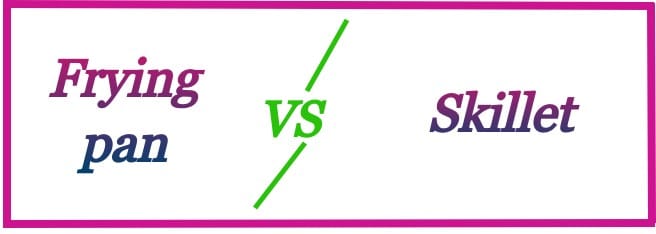The frying pan and skillet are both used for cooking food. Most people think both are the same, but there is some difference between a frying pan and a skillet. In this article, we will discuss the difference between a frying pan and a skillet.

In the realm of culinary essentials, the terms “skillet” and “frying pan” are often used interchangeably, leading to confusion about their nuances and purposes. In this in-depth exploration, we will dissect the characteristics, uses, and key differences between skillets and frying pans, providing a comprehensive guide for home chefs. Let’s embark on a culinary journey to understand when to reach for the skillet and when to embrace the frying pan.
Table of Contents
Understanding the Basics:
Before delving into the specifics, let’s establish a foundational understanding of both cookware items.
1. Skillet:
- Often characterized by its slanted or sloped sides.
- Comes with a long handle for easy maneuvering.
- Versatile and commonly used for sautéing, searing, frying, and even baking.
2. Frying Pan:
- Features a flat bottom and slightly higher, straighter sides compared to a skillet.
- Typically equipped with a long handle, although some variations may include a second helper handle.
- Suitable for a wide range of cooking techniques, including frying, stir-frying, searing, and shallow frying.
Comparing the Construction:
One of the primary distinctions between skillets and frying pans lies in their construction, affecting heat distribution and cooking performance.
1. Material:
Skillet:
- Commonly crafted from materials like cast iron or stainless steel.
- Cast iron skillets are celebrated for their heat retention and even heating capabilities.
- Stainless steel skillets offer durability and a sleek appearance.
Frying Pan:
- Materials include stainless steel, aluminum, non-stick coatings, or a combination of these.
- Aluminum pans provide rapid heat conduction, while non-stick coatings ease food release.
2. Shape and Design:
Skillet:
- Features slanted sides that facilitate easy flipping and tossing of ingredients.
- Ideal for dishes that involve liquids or sauces due to the sloped design.
Frying Pan:
- Straighter sides make it well-suited for tasks requiring containment, such as shallow frying or preparing dishes with more liquid.
Cooking Performance:
Both skillets and frying pans have their strengths and are designed for specific cooking tasks.
1. Versatility:
- Skillet:
- Excels in tasks like sautéing, searing, and frying.
- Sloped sides make it easier to stir and toss ingredients.
- Frying Pan:
- Suitable for a broader range of techniques, from frying and stir-frying to shallow frying and searing.
2. Heat Distribution:
- Skillet:
- Even heat distribution, especially in cast iron skillets, promotes consistent cooking results.
- Frying Pan:
- The choice of material influences heat distribution, with aluminum providing quick and uniform heating.
3. Cooking Surface:
- Skillet:
- The larger surface area allows for effective searing and browning of ingredients.
- Frying Pan:
- Straight sides provide a larger cooking surface compared to skillets with sloped sides.
Choosing the Right Tool for the Job:
Now equipped with insights into their construction and cooking performance, let’s explore when it’s best to opt for a skillet or a frying pan.
1. When to Use a Skillet:
- For dishes that involve liquids or sauces, as the sloped sides facilitate easy stirring and flipping.
- Ideal for searing meats, thanks to the larger surface area for browning.
2. When to Use a Frying Pan:
- Best suited for tasks that involve containment, such as frying or stir-frying.
- Perfect for dishes with a higher liquid content, as the straight sides help prevent spills.
Comparative Table:
To summarize the key differences:
| Feature | Skillet | Frying Pan |
|---|---|---|
| Sides | Slanted or sloped | Straight |
| Versatility | Sautéing, searing, frying | Frying, stir-frying, searing |
| Heat Distribution | Even, especially in cast iron | Influenced by material choice |
| Cooking Surface | Larger surface area for searing | Larger cooking surface with straight sides |
| Ideal for | Dishes with liquids or sauces | Containment tasks, frying, stir-frying |
Conclusion:
In the culinary arena, both skillets and frying pans are indispensable tools, each with its unique features and strengths. Understanding their construction, performance attributes, and when to employ them in the kitchen equips home chefs with the knowledge to elevate their culinary creations. Whether it’s the sloped sides of a skillet for effortless flipping or the straight sides of a frying pan for contained frying, these kitchen titans are ready to bring your culinary visions to life. So, the next time you stand before your stove, consider the nuances of skillets and frying pans, and let the sizzle of a perfectly cooked dish begin.